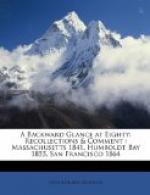One occurrence made a strong impression on me. It was war-time, and loyalty was an issue. A rancher from Mendocino County came to Eureka to prove up on his land and get a patent. He seemed to me a fine man, but when he was asked to take the oath of allegiance he balked. I tried my best to persuade him that it was harmless and reasonable, but he simply wouldn’t take it, and went back home without his patent.
My experiences while chief clerk in the office of the Superintendent of Indian Affairs are too valuable to be overlooked. I traveled quite freely and saw unfamiliar life. I had a very interesting trip in 1865, to inspect the Round Valley Indian Reservation and to distribute clothing to the Indians. It was before the days of railroads in that part of California. Two of us drove a light wagon from Petaluma to Ukiah, and then put saddles on our horses and started over the mountains to the valley. We took a cold lunch, planning to stay overnight at a stockman’s ranch. When we reached the place we found a notice that he had gone to a rodeo. We broke into his barn to feed our horses, but we spared his house. Failing to catch fish in the stream near by, we made our dinner of its good water, and after a troubled night had the same fare for breakfast. For once in my life I knew hunger. To the nearest ranch was half a day’s journey, and we lost no time in heading for it. On the way I had an encounter with a vicious rattlesnake. The outcome was more satisfactory than it might have been. At noon, when we found a cattleman whose Indian mate served venison and hot bread of good quality and abundant quantity, we were appreciative and happy. The remainder of the trip was uneventful.
The equal division of clothing or supplies among a lot of Indians throws helpful light on the causes of inequality. A very few days suffice to upset all efforts at impartiality. A few, the best gamblers, soon have more than they need, while the many have little or nothing.
The valleys of Mendocino County are fascinatingly beautiful, and a trip direct to the coast, with a spin along ten miles of perfect beach as we returned, was a fine contrast to hungry climbing over rugged heights.
Another memorable trip was with two Indians from the mouth of the Klamath River to its junction with the Trinity at Weitchpec. The whole course of the stream is between lofty peaks and is a continuous series of sharp turns. After threading its winding way, it is easy to understand what an almost solid resistance would be presented to a rapidly rising river. With such a watershed as is drained by the two rivers, the run-off in a storm would be so impeded as to be very slow. The actual result was demonstrated in 1861. In August of that year, A.S. Hallidie built a wire bridge at Weitchpec. He made the closest possible examination as to the highest point the river had reached. In an Indian rancheria he found a stone door-sill that had been hollowed by constant use for ages. This was then ninety-eight feet above the level of the flowing river. He accepted it as absolutely safe. In December, 1861, the river rose thirty feet above the bridge and carried away the structure.




